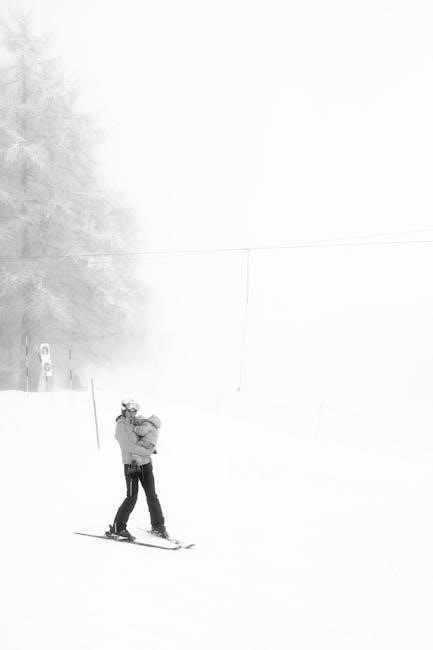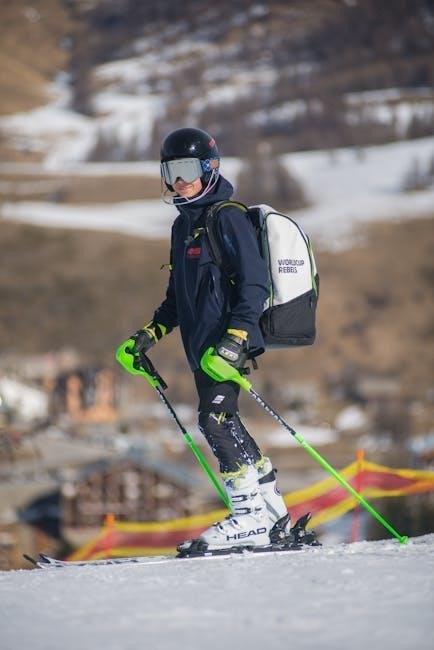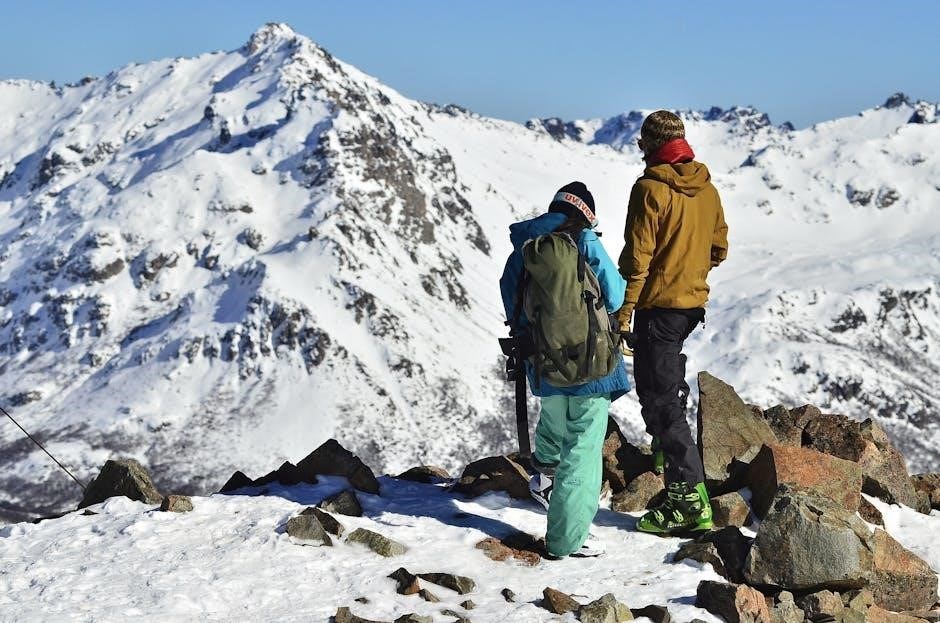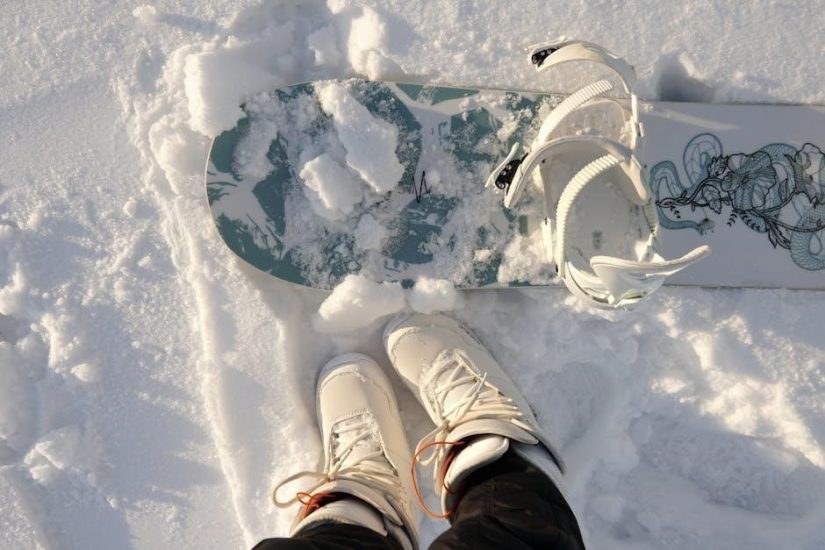Choosing the right ski boots is crucial for performance, comfort, and safety on the slopes. This guide helps you make informed decisions, ensuring the best fit and functionality for your skiing needs.
Understanding the Importance of Proper Fit and Performance
A proper fit is essential for optimal performance, comfort, and safety on the slopes. Ill-fitting boots can lead to discomfort, blisters, and reduced control, impacting your skiing experience. Performance depends on factors like flex, responsiveness, and alignment, ensuring boots match your skill level and skiing style. Correct fit enhances power transfer, precision, and confidence, while poor fit can cause fatigue and injury risks. Prioritizing both fit and performance ensures a more enjoyable, effective, and safe skiing experience, making them cornerstone considerations in your ski boot selection process.
Types of Ski Boots
Alpine, Nordic, and backcountry boots cater to different skiing styles. Alpine boots prioritize downhill performance, Nordic focus on cross-country agility, and backcountry boots blend hiking mobility with downhill capability.
Alpine Ski Boots
Alpine ski boots are designed for downhill skiing, offering precision control and high performance. Sturdy and responsive, they feature rigid shells and snug-fitting liners for optimal power transfer. Available in varying flex ratings, they suit skiers from beginner to expert levels. Advanced models include customizable fit options and modern technology like walk modes for easier movement off the slopes. Their focus on downhill performance makes them the most popular choice for resort skiing, ensuring a perfect blend of comfort and responsiveness for an enhanced skiing experience.
Nordic Ski Boots
Nordic ski boots are designed for cross-country skiing, emphasizing flexibility and mobility. They feature lightweight, low-cut designs to allow natural ankle movement, essential for striding and skating techniques. These boots prioritize comfort and breathability, often with moisture-wicking liners to keep feet dry. Compatible with NNN or SNS bindings, Nordic boots are ideal for long-distance skiing and varied terrain. Their simplicity and versatility make them perfect for both recreational and competitive skiers, ensuring a comfortable and efficient skiing experience in flat or rolling landscapes.
Backcountry Ski Boots
Backcountry ski boots are built for off-trail adventures, combining durability and versatility for varying terrain. They offer a balance of flexibility for hiking and stiffness for downhill performance. These boots feature waterproofing, insulation, and gaiter compatibility to withstand harsh conditions. Lightweight materials enhance mobility, while customizable liners and adjustable cuffs ensure a precise fit. Designed for skiers who explore beyond groomed trails, backcountry boots prioritize functionality, with features like tech bindings compatibility and rugged soles for challenging landscapes. They are essential for those seeking freedom and performance in remote, untouched snow territories.

Key Factors to Consider When Buying Ski Boots
When purchasing ski boots, key factors include fit, flex, weight, height, and performance level to ensure optimal comfort and skiing efficiency for all skill levels and preferences.
Fit and Sizing
Proper fit and sizing are the most critical factors when choosing ski boots. Ski boots should feel snug but not painfully tight, providing support without restricting movement. Try boots in the afternoon, as feet tend to swell during the day. Wear thin ski socks to ensure accuracy. A professional boot fitter can help determine the best size and shape for your foot. Boots should hold your heel firmly, with minimal toe movement. Avoid boots that cause pressure points or discomfort. Proper fit ensures better performance, control, and comfort on the slopes, making it essential to prioritize this aspect during your selection process.
Flex and Performance Level
Finding the right flex and performance level is essential for optimal skiing. Flex refers to a boot’s stiffness, which impacts control and responsiveness. Softer flex boots are ideal for beginners or casual skiers, offering ease of movement, while stiffer boots suit advanced skiers needing precise control. Performance level aligns with skier ability: entry-level boots prioritize comfort, mid-range boots balance performance and ease, and high-performance boots deliver superior power for expert skiers. Ensuring the flex and performance level match your skiing style ensures better control, efficiency, and overall enjoyment on the slopes. Proper alignment with your ability enhances the skiing experience significantly.
Weight and Height Considerations
Weight and height play a significant role in choosing the right ski boots. Lighter skiers may prefer softer flex boots for easier movement, while heavier skiers often benefit from stiffer boots for better control. Height influences boot size, with taller skiers requiring longer boots for proper fit. However, boot fit should prioritize comfort and performance over height alone. Ensure boots align with your skiing ability and body type. Proper sizing prevents discomfort and enhances control, making your skiing experience more enjoyable. Always consider weight and height alongside other factors for the best fit. This ensures optimal performance and comfort on the slopes.
Features to Look for in Ski Boots
Look for warmth, waterproofing, and adjustability in ski boots. These features enhance comfort and performance, ensuring a great skiing experience regardless of conditions or skill level.
Warmth and Insulation
Warmth and insulation are critical for comfort during long days on the slopes. Look for boots with high-quality insulation materials like Thinsulate or similar technologies. Moisture-wicking liners help keep feet dry, while waterproof membranes prevent external moisture from entering. A well-insulated boot retains heat even in freezing conditions, ensuring your feet stay warm. Many boots also feature adjustable temperature ratings, catering to different skiing environments. Customizable insoles can further enhance warmth and fit. Prioritizing insulation ensures that your feet remain comfortable, allowing you to focus on your skiing performance without distraction from cold or discomfort.
Waterproofing and Durability
Waterproofing and durability are essential for ski boots to withstand harsh winter conditions. High-quality boots feature waterproof membranes, such as Gore-Tex, to prevent moisture from entering. Durable materials, like reinforced plastics and rubber soles, ensure longevity. Look for boots with sealed seams and water-resistant treatments to maintain dryness. Durability also impacts performance, as sturdy construction helps maintain responsiveness and support. Proper care, including applying waterproofing sprays, can extend the life of your boots. Prioritizing waterproofing and durability ensures your boots remain reliable and comfortable season after season, whether you’re carving groomed trails or tackling backcountry terrain.
Adjustability and Customization Options
Adjustability and customization are key features to look for in ski boots, ensuring a personalized fit and enhanced performance. Many boots offer adjustable cuffs, buckles, and lacing systems, allowing you to tailor the fit to your leg shape and skiing style. Heat-moldable liners are another valuable option, conforming to your foot over time for superior comfort. Removable insoles and adjustable flex ratings also provide flexibility for varying conditions. Customization options ensure your boots adapt to your needs, whether you’re carving groomed trails or exploring backcountry terrain, making every skiing experience more enjoyable and responsive.
How to Try On Ski Boots
When trying on ski boots, wear thin ski socks and ensure a snug fit without pressure points. Check flex and comfort, and consider visiting a professional fitter for optimal results.
Step-by-Step Guide for the Best Fit
- Wear thin ski socks to ensure an accurate fit and mimic on-mountain conditions.
- Slide your foot into the boot, ensuring your heel sits snugly at the back.
- Check for pressure points; there should be no pain or excessive tightness.
- Flex the boot slightly to gauge comfort and responsiveness.
- Compare sizes across brands, as fits can vary significantly.
- Consider visiting a professional boot fitter for personalized adjustments.
- Test the boot while standing to assess how it performs in a skiing stance.
- Ensure the boot aligns with your skiing ability and preferred terrain.
Common Mistakes to Avoid When Buying Ski Boots
- Not trying boots on with proper socks: Wear the same thickness of socks you’ll use skiing.
- Prioritizing cost over quality: Cheap boots may compromise comfort and performance.
- Not considering skiing ability: Choose boots that match your skill level and terrain preferences.
- Rushing the process: Take time to try multiple brands and models for the best fit.
- Ignoring professional advice: A boot fitter can provide personalized recommendations.
Avoiding these mistakes ensures a better fit, improved performance, and a more enjoyable skiing experience.

How to Break In Your Ski Boots
- Try them on with proper socks: Wear the same thickness of socks you’ll use skiing to ensure a true fit.
- Heat fitting: Many boots can be heat-molded by professionals to contour to your feet.
- Gradual wear: Start with short sessions (30 minutes) and increase time to allow the boots to mold naturally.
- Walk around: Spend time walking indoors to simulate skiing movements and soften the material.
- Adjust liners: Remove and shape liners separately if possible for added comfort.
- Be patient: Breaking in boots takes time; don’t rush the process to avoid discomfort.
- Seek professional help: If pain persists, consult a boot fitter for modifications.
Proper break-in ensures optimal comfort, performance, and longevity of your ski boots.

Maintenance and Care Tips for Ski Boots
Proper care ensures your ski boots remain comfortable and perform well over time. After use, clean the exterior with a damp cloth and mild soap to remove dirt and bacteria. Allow boots to air dry thoroughly, avoiding direct heat to prevent damage. Store them in a cool, dry place, away from direct sunlight. Regularly condition the liners and apply waterproofing spray to the exterior. Check for worn-out parts and replace them promptly. Proper maintenance extends the life of your boots and maintains their performance on the slopes.

Compatibility With Skis and Bindings
Ensuring your ski boots are compatible with your skis and bindings is vital for optimal performance and safety. Check boot size, binding type, and sole length for a seamless fit.
Alpine Skis
Alpine ski boots are designed for precise control and power on the slopes. Ensuring compatibility with Alpine skis and bindings is essential for optimal performance and safety. The boot’s sole type and size must match the binding specifications to ensure a secure fit and proper function. Boot flex also plays a crucial role, with stiffer boots offering better response for aggressive skiing. Proper compatibility ensures efficient energy transfer from boot to ski, enhancing turning and control. Always check compatibility to maximize your skiing experience and safety on the mountain.
Nordic Skis
Nordic ski boots are designed for cross-country skiing, emphasizing flexibility and lightweight construction. Compatibility with Nordic skis focuses on the boot’s binding system, often using NNN or SNS bindings. The boot’s sole and width must align with the binding for secure attachment and efficient energy transfer. Nordic boots prioritize comfort and mobility, allowing for a natural stride during skiing. Proper fit ensures support and performance, while features like insulation and waterproofing enhance comfort in cold conditions. Selecting boots tailored to your skiing style and terrain ensures an optimal experience on the trails.
Selecting the right ski boots is a crucial decision that directly impacts your skiing experience. Proper fit, performance, and compatibility with your skis and bindings are essential for comfort, safety, and enjoyment. Consider your skiing style, ability level, and the terrain you frequent when making your choice. Regular maintenance and care will extend the life of your boots and ensure optimal performance. By following this guide, you’ll be well-equipped to make an informed decision, allowing you to focus on what truly matters—enjoying the slopes with confidence and precision.
